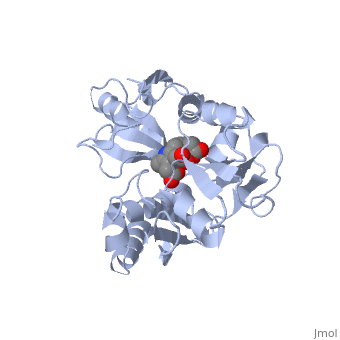Porphobilinogen Deaminase
From Proteopedia
(Difference between revisions)
| Line 1: | Line 1: | ||
| - | <StructureSection load='1ypn' size='450' side='right' scene='' caption=''> | + | <StructureSection load='1ypn' size='450' side='right' scene='' caption='Structure of E. coli porphobilinogen deaminasecomplex with dipyrromethane cofactor (PDB code [[1ypn]]).'> |
'''Porphobilinogen deaminase''' (PBGD) also known as Hydroxymethylbilane synthase, is a monomeric deaminase and is the third enzyme in the heme biosynthesis pathways in mammals<ref name="Raj">PMID: 19207107</ref>. It catalyses the polymerization of four porphobilinogen molecules to yield hydroxymethylbilane, a precursor in the formation of [[Porphyrin]]<ref name="Peter">PMID:3079571</ref>. Porphobilinogen deaminases are able to form surprisingly stable enzyme-substrate complexes with up to four pyrrole substrates interacting with the active site, a feature unique to the group of enzymes<ref name="Anderson">PMID:7354069</ref>. <scene name='Sandbox_Reserved_349/Dpm/3'>Dipyrromethane (DPM)</scene>, a cofactor unique to porphobilinogen deaminases, is thought to stabilize these interactions at each of the two active domains<ref name="Peter">PMID:3079571</ref>. Mutations in the human PBGD (hPBGD) gene are responsible for the condition Acute Intermittent Porphyria (AIP) in humans<ref name="Raj">PMID: 19207107</ref>. | '''Porphobilinogen deaminase''' (PBGD) also known as Hydroxymethylbilane synthase, is a monomeric deaminase and is the third enzyme in the heme biosynthesis pathways in mammals<ref name="Raj">PMID: 19207107</ref>. It catalyses the polymerization of four porphobilinogen molecules to yield hydroxymethylbilane, a precursor in the formation of [[Porphyrin]]<ref name="Peter">PMID:3079571</ref>. Porphobilinogen deaminases are able to form surprisingly stable enzyme-substrate complexes with up to four pyrrole substrates interacting with the active site, a feature unique to the group of enzymes<ref name="Anderson">PMID:7354069</ref>. <scene name='Sandbox_Reserved_349/Dpm/3'>Dipyrromethane (DPM)</scene>, a cofactor unique to porphobilinogen deaminases, is thought to stabilize these interactions at each of the two active domains<ref name="Peter">PMID:3079571</ref>. Mutations in the human PBGD (hPBGD) gene are responsible for the condition Acute Intermittent Porphyria (AIP) in humans<ref name="Raj">PMID: 19207107</ref>. | ||
Revision as of 08:26, 31 July 2014
| |||||||||||
3D structures of porphobilinogen deaminase
Updated on 31-July-2014
3eq1 – hPBGD (mutant) + dipyrromethane cofactor – human
3ecr - hPBGD + dipyrromethane cofactor
1gtk, 2ypn, 1ah5, 1pda - EcPBGD + dipyrromethane cofactor – Escherichia coli
1ypn - EcPBGD (mutant) + dipyrromethane cofactor
4htg – PBGD – Arabidopsis thaliana
4mlq, 4mlv – PBGD – Bacillus megaterium
References
- ↑ 1.0 1.1 1.2 1.3 1.4 1.5 1.6 Gill R, Kolstoe SE, Mohammed F, Al D-Bass A, Mosely JE, Sarwar M, Cooper JB, Wood SP, Shoolingin-Jordan PM. Structure of human porphobilinogen deaminase at 2.8 A: the molecular basis of acute intermittent porphyria. Biochem J. 2009 Apr 28;420(1):17-25. PMID:19207107 doi:10.1042/BJ20082077
- ↑ 2.0 2.1 2.2 Jordan PM, Warren MJ. Evidence for a dipyrromethane cofactor at the catalytic site of E. coli porphobilinogen deaminase. FEBS Lett. 1987 Dec 10;225(1-2):87-92. PMID:3079571
- ↑ Anderson PM, Desnick RJ. Purification and properties of uroporphyrinogen I synthase from human erythrocytes. Identification of stable enzyme-substrate intermediates. J Biol Chem. 1980 Mar 10;255(5):1993-9. PMID:7354069
- ↑ A.R. Battersby, F.J. Leeper. Biosynthesis of the pigments of life: mechanistic studies on the conversion of porphobilinogen to uroporphyrinogen III. Chern. Rev. 1990 Nov;90(7):1261-1274
- ↑ 5.0 5.1 Lander M, Pitt AR, Alefounder PR, Bardy D, Abell C, Battersby AR. Studies on the mechanism of hydroxymethylbilane synthase concerning the role of arginine residues in substrate binding. Biochem J. 1991 Apr 15;275 ( Pt 2):447-52. PMID:2025226
- ↑ A.R. Battersby, F.J. Leeper. Biosynthesis of the pigments of life: mechanistic studies on the conversion of porphobilinogen to uroporphyrinogen III. Chern. Rev. 1990 Nov;90(7):1261-1274
- ↑ 7.0 7.1 Whatley S.D., Roberts A.G., Llewellyn D.H., Bennett C.P., Garrett C, Elder G.H. (2000). Non-erythroid form of acute intermittent porphyria caused by promoter and frameshift mutations distant from the coding sequence of exon 1 of the HMBS gene. Hum. Genet. 107 (3): 243–248.
- ↑ Aarsand AK, Petersen PH, Sandberg S. Estimation and application of biological variation of urinary delta-aminolevulinic acid and porphobilinogen in healthy individuals and in patients with acute intermittent porphyria. Clin Chem. 2006 Apr;52(4):650-6. PMID:16595824 doi:10.1373/clinchem.2005.060772

